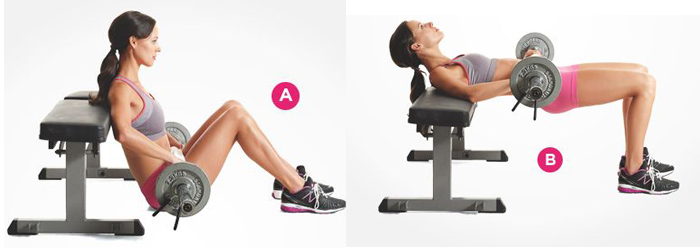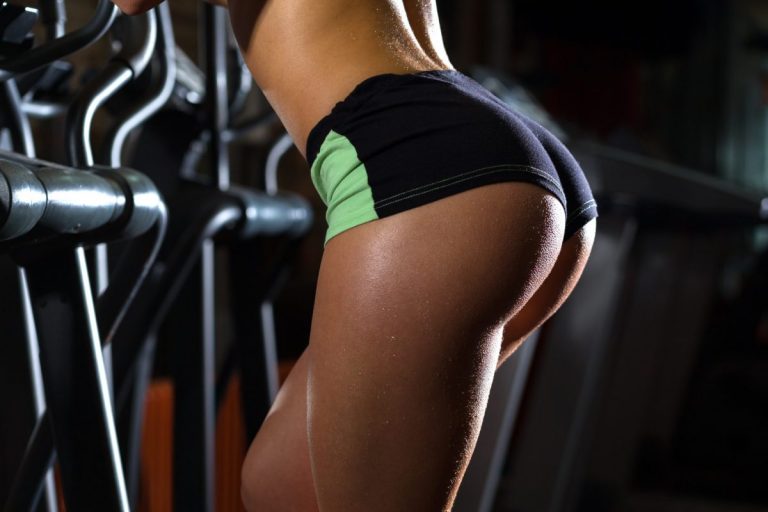Hip thrust, or hips rising with the back placed at a small height, is a less popular buttock exercise than squat. However, with regards to the involvement of the buttock muscles and the effectiveness of forming a rounded, firm butt - definitely wins with sit-ups. Read about the technique of hip thrust and what effects this exercise gives. Hip thrust is a great exercise for those who want to have strengthened and nicely shaped buttock without developing quadriceps muscle. Hip thrust can also be used as an additional exercise for runners and even martial arts students. Pushing the hips with the back raised is the most effective way to shape the buttocks.
Hip thrust - what is it? Hip thrust and squats
Hip thrust lies in the hip joint, which is the major function of the large buttock muscle. In a study conducted by scientists at Aukland University of Technology, hip thrust involves engaging the muscle to work much better than squat. In 2015, we tested 13 athletic women who made 30 sit-ups and 30 hip thrusts based on a bench and barbell. The difference in maximum moment of muscle tension was shown.
In the case of hip thrust, the maximum tension appears in the position of the pectoral muscle contraction and the straightening of the hip joint, while in the case of squats - at the moment of the buttock flexion and bending in the hip. It has been unequivocally determined from the EMG study that hip thrust rather than squats involve the lower and upper buttocks of the large buttocks muscle and the biceps of the thigh, but to a lesser degree the quadriceps of the thigh, which prevents the body from expanding too much. Hip thrust engages 70-87% of the buttocks, and sit-ups - 30-45%. Hip thrust in the eccentric phase, i.e. lowering the hips, stretching the buttocks, and in the concentric phase (lifting the hips) it gains them.
Contrary to what it may seem, squats are also technically more difficult than hip thrust - to do them properly, greater mobility in the ankle and hip and greater flexibility of the thigh adductor muscles is needed. Hip thrust does not affect the lumbar spine, as is the case with squats or dead traction.

Hip thrust - basic technique
To start the exercise, take the appropriate position. Lean with your torso on a bench (or chair) at an angle of 45 degrees to the ground, hands bent at the elbows and hold close to the torso. Aim your toes outwards. Bend your knees wide apart and lean firmly against the ground, lift your head slightly upwards, and look forwards (not up or down, because it will make you get less muscle tone).
Movement should begin with the pelvic fold, which means tightening the abdominal and buttocks muscle. It's not about hunching up the hips at all costs, because it can end up with hyperextension in the lumbar spine, which is tightening of the ridge rectifiers and the stretching of the abdominal muscles. We flex the abdominal muscles and twist our buttocks, then straighten the hips to the end, clamping the buttocks to the limit. Your torso should now be in a parallel position to the ground. Lower your body to the starting position, clamping your buttocks all the time.
Ultimately repeat hip thrust 15 times in 3 series - if you are just starting your adventure with this exercise, you can do fewer reps (8-10).
Hip thrust with a barbell
In this version, thanks to the extra weight in the form of a barbell, buttocks work even harder.
Lean your back against a bench at a 45 degree angle to the ground. Bend your knees, and set feet with your toes pointing outward and with legs widely apart, firmly rest them on the ground. Head slightly up, look forward. Place bar at hip height. Roll up the pelvis and then firmly hold the bar. Remember to keep your wrists straight. Stabilize the shoulders and try to lift the weight not the lower back and use the buttocks. Remember to let your knees go outwards, that is, to spread out. Clamp your buttocks as best you can and straighten your hips so that you are in a position parallel to the ground. Slowly lower the weight, keeping the tension in the abdominal muscles and in the buttocks. Repeat the exercise 15 times in 3 series.
Exercise with a barbell can cause discomfort, so it is worth to put a sponge under the bar - sponges can be bought in sports shops. Place in the centre of the bar, with the Velcro facing up. The problem can also be to put the barbell on you - it is best to ask someone for help or choose a device with large plates to be able to put it on.







3 Comments